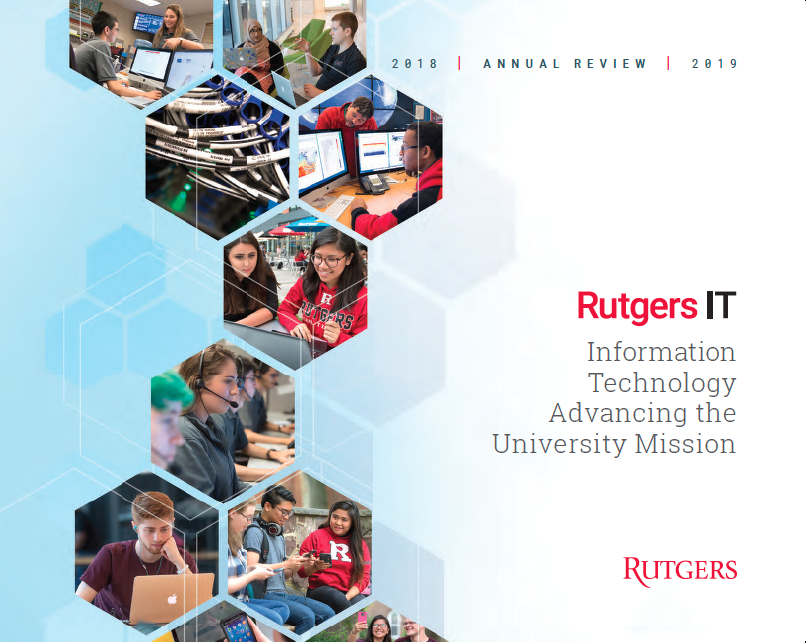Rutgers IT Annual Review

Michele Norin
Senior Vice President
and Chief Information Officer
Message from the Senior Vice President and Chief Information Officer
Technology professionals have a reputation for toiling in solitude. That’s the stereotype, at least—the lone coder hunched in front of a glowing monitor. And though there’s certainly a place for solitary stretches in IT work—I got my start, after all, as a COBOL programmer—the fact is today’s IT world is highly collaborative. You can’t really accomplish much if you don’t emerge from your cubicle or office. When I arrived at Rutgers four years ago, one of my priorities was to foster a more integrated, aligned, and collaborative IT community across the university. That’s not because we wanted an IT community just for the sake of having one. It was because it was clear we would need vibrant, effective partnerships and relationships to make significant progress in providing a comprehensive, cost effective IT environment for Rutgers.
The projects and initiatives highlighted in this publication are a testament to how far we have come. Behind just about every accomplishment is a collaboration—sometimes with faculty (as in the transition to the Canvas learning management system), sometimes with Rutgers business units (for Cornerstone initiatives), and often between staff from the Office of Information Technology (OIT) and “distributed” IT at Rutgers schools, departments, and other units. Information technology professionals from across Rutgers have been working diligently to cultivate these collaborations. Their work in doing this is thoughtful, it is intentional, and it is making a real difference to the university.
Consider the Information Technology Leadership Council (ITLC), a group of nearly 60 IT leaders from every corner of Rutgers. Our first meeting was held more than three years ago. This was something new—an effort to bring together leaders from OIT and distributed units. Our initial discussions were sometimes contentious, but they were also respectful, and over time we have developed a vibrant, innovative community that’s vital to advancing IT initiatives at Rutgers. Hundreds of IT staff members from across Rutgers now serve on committees and working groups associated with the ITLC. More than 110 IT staff members have attended a specialized program for IT leaders, encouraging a common language for collaboration among IT staff. Our ability to work together has led to the successes in evidence throughout this publication. That’s our standard now—a collaborative approach to advance Rutgers’ missions of teaching, research, and service.
Sincerely,
![]()
Michele L. Norin
Tech Support for Ever-Expanding Services
phone calls answered
walk-in support sessions
Next-Gen Meetings and Collaboration
files on SharePoint sites
Skype and Teams peer-to-peer collaborations
minutes of Webex meetings
individual users on Skype
Webex meetings hosted
Securing, Protecting, and Managing Rutgers Data
new devices migrated to Cisco Advanced Malware Protection (AMP)
malicious network attacks blocked
Advanced Computing, Revolutionary Research
trillion mathematical operations per second, peak performance
Rutgers units performing research on systems maintained by the Office of Advanced Research Computing (OARC)
faculty, staff, and students from 130 Rutgers departments attended high-performance computing training since 2017 inception
dollars new research awards for Amarel-partnered projects since March 2016
Rutgers students, researchers, and faculty work and learn on Amarel
Did You
Know?
Robotic gliders tracking hurricanes in world’s oceans
The Rutgers Center for Ocean Observing Leadership (RUCOOL) collaborated with the Navy and other partners to deploy over 60 robotic ocean gliders, coordinating real-time data delivery to develop operational ocean models for hurricane forecasting. RUCOOL recently celebrated the 500th glider deployment.
Fostering digital skills with a Newark high school
A program with East Side High School in Newark provided technology training and internships, with students learning 3D printing, content management systems, and web development with Python, HTML, and JavaScript.
900 nursing simulations
At the School of Nursing–Camden, IT provides the technology to record and evaluate over 900 nursing simulations each academic year.
2.1 million patient visits
Electronic health records and other technologies aid in patient care at Rutgers faculty practices, clinics, and centers.
Read the Annual Review
If you liked those numbers, there’s more where that came from! The Rutgers IT Annual Review highlights the breadth and scope of IT’s reach at Rutgers, from high-performance computing to videoconferencing solutions. Learn about what Rutgers IT has collectively accomplished this past year in our 2018-2019 Annual Review.
